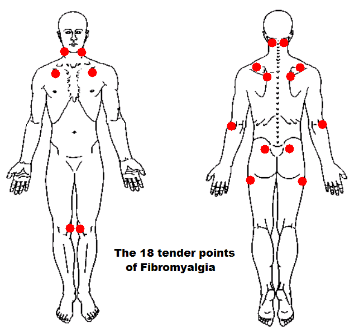
Fibromyalgia is a painful condition of the soft tissues, primarily the muscles, that affects approximately 3.7 million Americans. It causes widespread pain, stiffness, fatigue, and poor sleep patterns. Most people with fibromyalgia say that they ache all over. More women than men are afflicted with fibromyalgia, but it shows up in people of all ages.
At this time, there is no diagnostic test available; therefore, its diagnosis is based on symptoms. A person with fibromyalgia has had pain for at least 3 months on the right and left side of the body both above and below the waist. There are also 18 standard points on the body that tend to be tender on people with fibromyalgia. Of these 18 points, 11 must be tender for the diagnosis of fibromyalgia. A big impact can be made on fibromyalgia through the use of exercise, diet, nutritional supplements, and chiropractic care.
What is Fibromyalgia?
Fibromyalgia is defined as a chronic illness condition that is characterized by widespread pain, tenderness, fatigue, stiffness, and sleep disturbances to name just a few of the symptomatology. The widespread pain occurs on both sides of the body, above and below the waist, and along the spine. Localized pain also much occur in a majority of identified "tender points" all over the surface of the body.
Do I Have Fibromyalgia?
A patient must have several symptoms present so that the diagnosis of fibromyalgia can be confirmed. Many patients have the symptoms but may not even know what fibromyalgia is. Other have been told by their MD that they "are on their way" to having fibromyalgia soon if nothing is done.
Other General Signs and Symptoms:
| Skeletal pain and whole body aches | Fatigue | Trouble sleeping |
| Depression | Chronic headaches | Anxiety |
Trigger Points
Trigger points are areas of tenderness in a muscle and may be associated with myofascial pain syndromes of fibromyalgia. If you suffer with 11 of the 18 points, you may be suffering with fibromyalgia. Please discuss these points while consulting your FCA doctor.
What Can Be Done?
Treatment begins when you are ready to find out the cause of your problem. Let one of the trained doctors at Fibromyalgia Centers of America start you on the path to health. It begins with consulting your trained professional. After the consultation. an in-depth exam will be performed if you qualify for treatment.
Chiropractic
Chiropractic cannot cure fibromyalgia, but it can significantly increase the quality of life for people with fibromyalgia. Chiropractic adjustments can help to reduce pain and increase flexibility by restoring motion to the joints of the back, neck, and extremities. In addition, chiropractors use different therapies that can help decrease pain and spasms in the muscles. Patients with fibromyalgia in our office have found that regular chiropractic adjustments give them the energy and the good night's sleep that they need in order to do their normal daily activities. That in itself goes a long way in helping decrease the symptoms of the fibromyalgia.
Fibromyalgia is a condition that affects every aspect of a person's life. However, with conservative therapies, its impact can be greatly reduced, and people who have this condition can have their life back.
Exercise
Unless people with fibromyalgia begin a daily aerobic exercise regimen, they will never notice much improvement in their condition. Exercise works through its hormonal effect on pain and sleep. Also, people with fibromyalgia appear to have a decrease in blood flow to their muscles, so exercise can help to increase that flow.
Fibromyalgia patients will have pain while exercising, but they should pick an exercise that doesn't worsen their condition. Some good exercises are walking, regular/exercise bikes, and a water exercise program. In order to be effective, the exercise must produce a sustained elevation of the heart rate for at least 30 minutes a day. Stretching also helps reduce pain by lengthening and relaxing the muscles. At least 15 minutes should be spent stretching before exercising, and the painful muscles should be stretched at least 3 times a day.
Diet
A change in diet can have a profound effect on people with fibromyalgia. Fibromyalgia patients should eat a balanced, whole foods diet. Every effort should be taken to minimize sugar intake as it adversely affects energy levels when eaten excessively. Acid-forming foods such as red meats, caffeine, and carbonated drinks should also be avoided, and saturated fats found in refined foods should be reduced. Eliminating common food allergies such as milk, corn, wheat, eggs, and nightshade vegetables such as tomatoes, potatoes, pepper, and eggplant has done wonders for some people. Adequate protein intake is also important because it is used for tissue repair.
Nutritional Supplements
Recent studies have found that magnesium and malate supplements can help reduce some of the symptoms of fibromyalgia. A study published in the Journal of Nutritional Medicine found that the fibromyalgia patients studied had significantly lower levels of magnesium in their red blood cells than people without fibromyalgia. This coincides with the fact that the symptoms of muscle pain, fatigue, sleep disturbances, and anxiety found in fibromyalgia are also the symptoms found in people with low levels of magnesium in their system. Magnesium and malate also play a critical role in the production ATP, the body's storage molecule for energy. It is hypothesized that ATP is not produced as readily in the muscles of fibromyalgia patients, so taking magnesium and malate supplements can help increase the amount of ATP produced.
